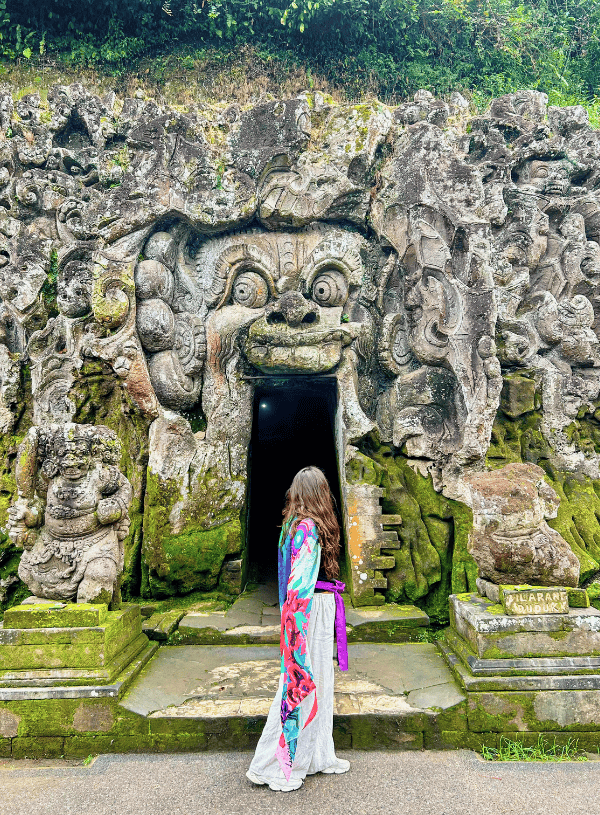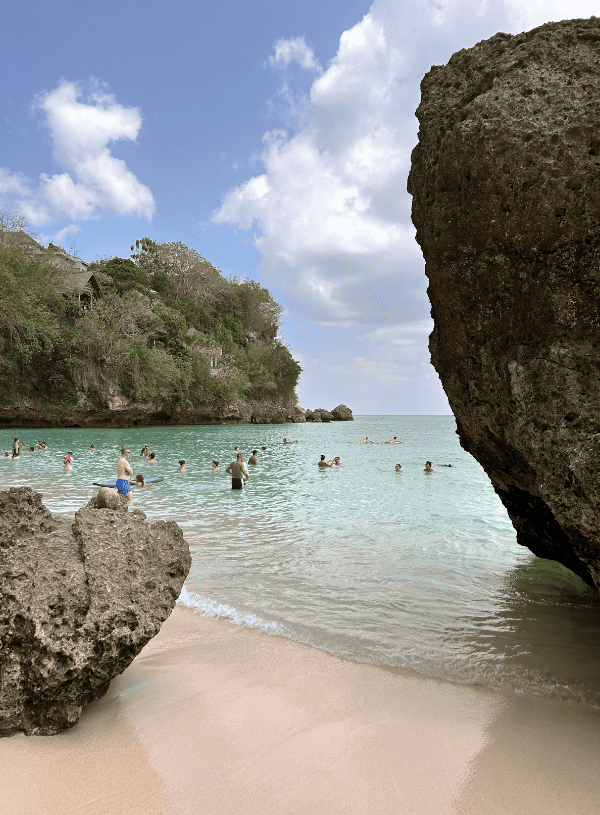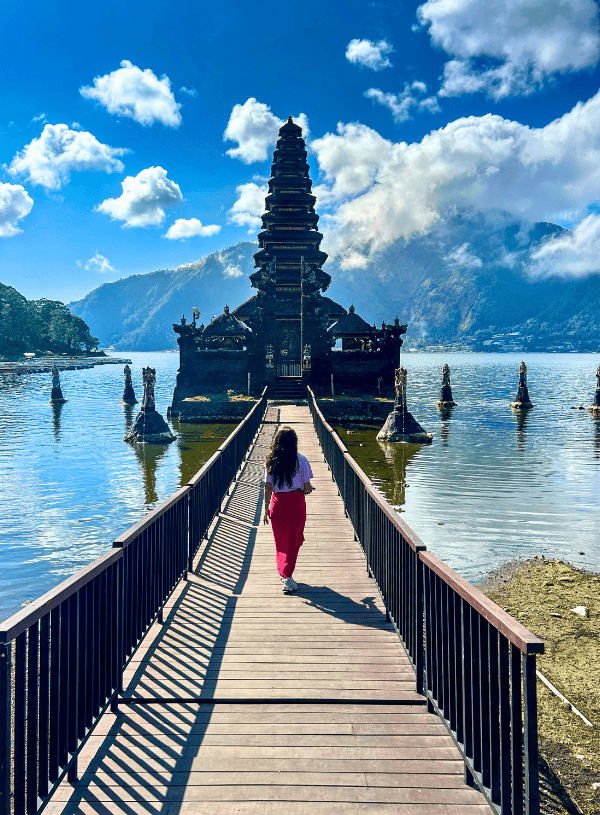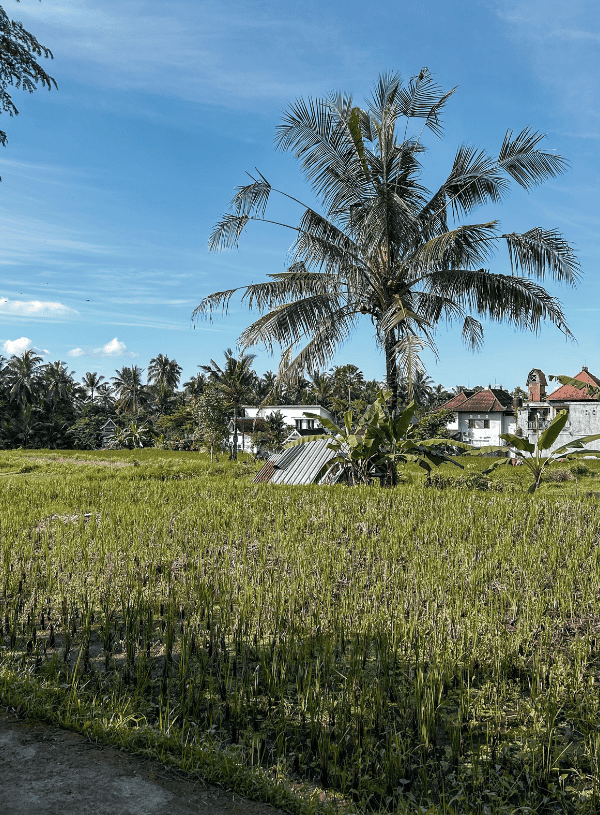2025 Ubud Travel Guide: Things To Do, Where To Stay & Day Trips Ideas
Last Updated on November 1, 2025
Planning a trip to Ubud and wondering how to experience this magical town in the best way possible? You’re in the right place!
I’ve been living in Ubud for the past few months, and I’ve seen it and tested it all: the crowds, the traffic, the hidden, beautiful corners, the most delicious Warungs, and the best rice fields to witness the most authentic Balinese daily life.
As you’ve probably read everywhere, Ubud is often called Bali’s spiritual and artistic heart. Yes, it’s home to some of the island’s most marketed spiritual experiences, but above all, it’s the energy here that feels special.
In this Ubud travel guide, I’ll share all my wisdom after months of living here: best hotels and areas to stay, my favorite restaurants and cafes, popular and niche experiences, places to see…all the things!
This article may contain affiliate links. This means that if you purchase through one of the links, I may be paid a small commission at no extra cost to you. Thank you for supporting the blog and allowing me to keep sharing meaningful travel experiences with you.
Don’t have time now?📌 Save it for later!
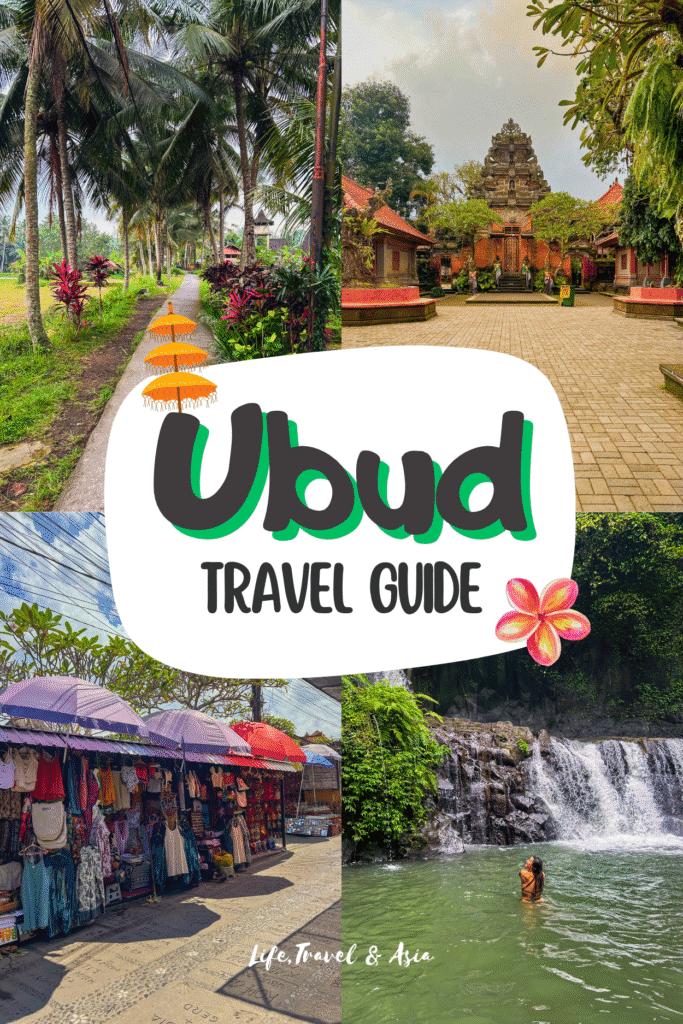
Is Ubud Worth Visiting?
Ubud completely stole my heart (so much so, I moved here), so the answer is yes—Ubud is absolutely worth visiting!
What struck me first about Ubud was that, despite the chaotic traffic on Jl Raya, the main road, you can find stillness and silence just a few steps away, in the surrounding rice fields. And I’m not talking about trekking miles outside the city center; literally, five minutes, and you’re immersed in a completely different world, free from traffic noise.
Another aspect I loved, especially for someone like me living here, is the cozy atmosphere. Ubud feels small and intimate, yet it has everything you need: charming cafes perfect for working remotely, yoga studios, tons of vegan options, cute shops selling local crafts, and even upscale restaurants.


.
Third, but no less important, Ubud is an ideal base for day trips to explore other parts of Bali. Around Ubud, you’ll find plenty of waterfalls to explore, hidden temples off the usual tourist paths, and hiking trails that will make your stay so exciting! This is all I’ll be sharing in this Ubud travel guide!
Travel Guide To Ubud: General Tips
Below are a couple of recommendations to help you make your arrival in Bali as smooth as possible.
Airport Transfer
The easiest way to get to Ubud from the airport is by pre-booking a private car transfer. Your driver will wait for you to clear passport control and baggage claim, ready to take you to your hotel.
I keep using Klook for all my planned transfers in Bali, and the service is 10/10 every time. So, if you’re looking for a trustworthy transfer, that’s my recommendation!
E-Sim
Now that eSIMs are readily available, I won’t travel without one. It’s so convenient! You can purchase an eSIM online and install it before your flight. Once you arrive in Bali, activate it, and you’re good to go.
Mosquitoes
Ubud is surrounded by the jungle and rivers, making it a paradise for insects (especially mosquitoes!). Pack a strong mosquito repellent and apply it whenever you leave your hotel, even if you stay indoors.
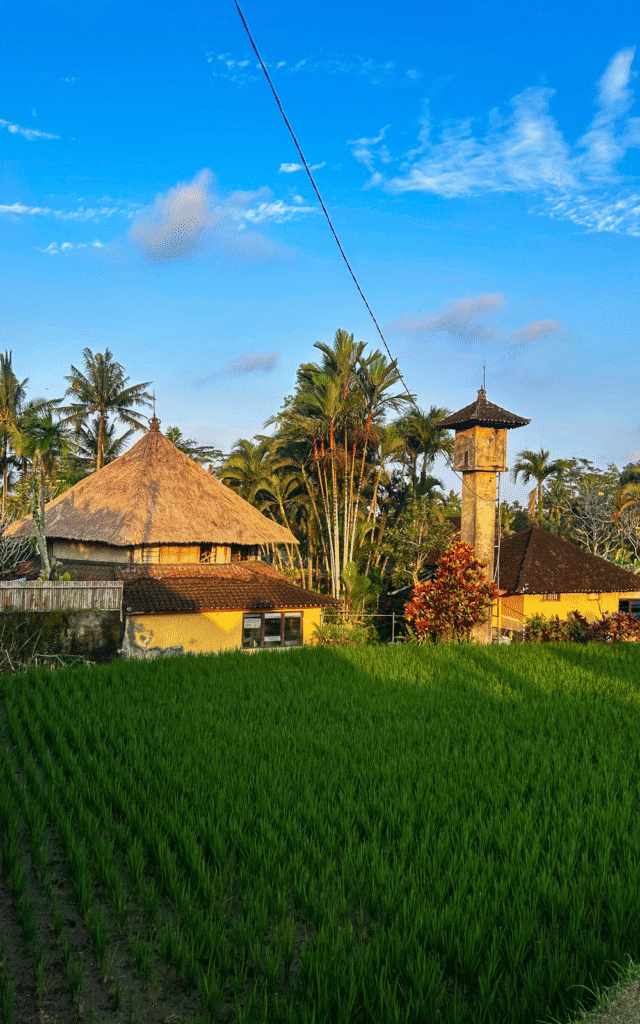
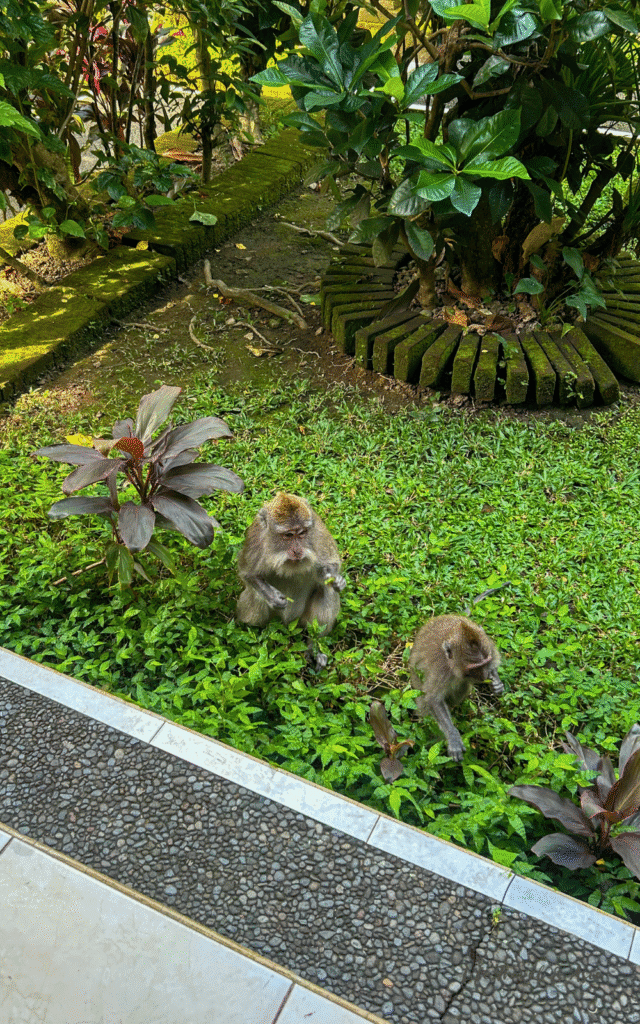
Gojek/Grab
If you prefer not to drive yourself, Gojek and Grab are the best ways to get around Ubud. These apps allow you to book taxis and scooter rides. Make sure to ask your driver for a helmet (they usually carry one for passengers).
Watch Your Step
The roads in Ubud aren’t always as well-maintained as you might be used to. So, pay attention to where you’re walking. It’s not uncommon to hear stories of people tripping on uneven pavement or stepping into holes and getting injured, so keep your eyes peeled!
If it’s your first trip, check out the 30 things I wish I’d known before traveling and moving to Bali. I know… 30 sounds like a lot, but I’m sure you wish you knew a couple of them too!
How to Get to Ubud?
Ubud is located in Gianyar Regency, about 40 kilometers from the airport. Depending on your arrival time, the journey to Ubud can take up to two hours, especially during the afternoon rush hour.
While you could consider other options like taxis and ride-hailing services, a pre-booked private car is the most convenient and comfortable option, especially after a long flight. Many drivers and agencies will try to get your attention upon arrival, but they often charge significantly more than pre-booked transfers (based on my experience).
For example, my ride from the airport to Ubud (a 1.30 journey) cost around $18, which I considered a fair price, especially since drivers typically wait up to two hours after your flight lands.

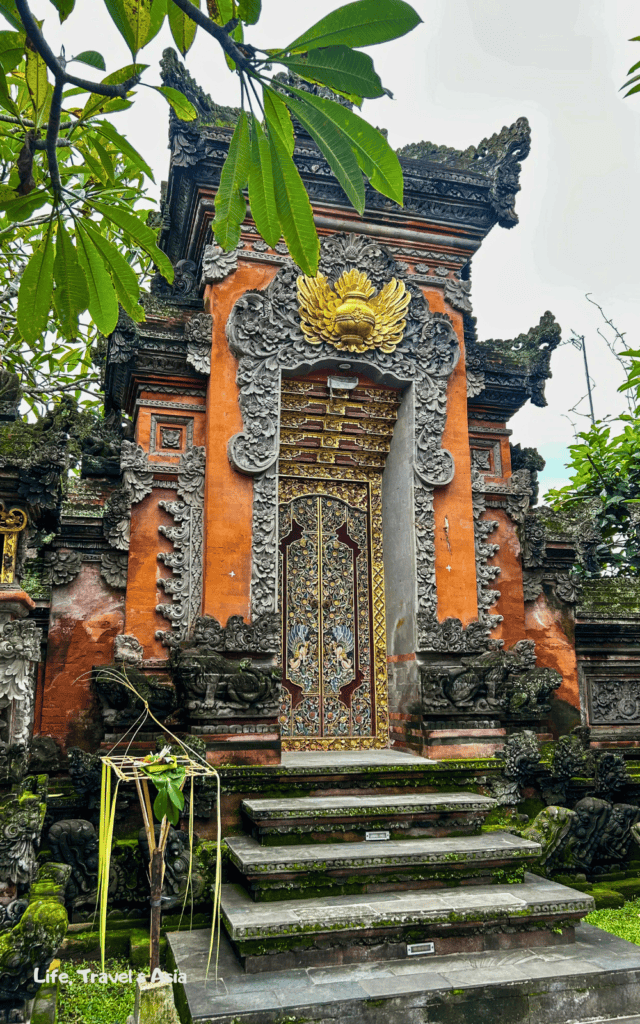
How to Get Around in Ubud?
Ubud’s city center is easy to explore on foot. Everything revolves around the main road, Jalan Raya, where you’ll find sights like the Royal Palace and Saraswati Temple, and starting points for rice paddy walks like the Campuhan Ridge Walk and the Kajeng Rice Fields.
Ride-hailing apps are a great option for exploring areas just outside Ubud. There are usually many drivers available (unless it’s raining, in which case you might have a longer wait).
If you’re comfortable driving in traffic (and Ubud traffic is wild!) and prefer to explore independently, renting a scooter is another possibility. Renting gives you maximum flexibility and is very affordable, with daily rentals starting around IDR 70,000 ($4), depending on the model.
To rent a scooter, you’ll need an international driving permit. And, of course, you should have travel insurance.
Scooter Parking
Finding parking in Ubud, especially for scooters, can be tricky due to heavy traffic and the high number of scooters. Most major attractions, like the Ubud Monkey Forest, have large parking areas nearby, usually charging a small fee of IDR 1,000-2,000 (paid in cash, so carry some small bills).
If you park on the street, be mindful of traffic and any potential parking fees. And very important: pay close attention to parking restrictions! I actually saw a police officer deliberately deflate a scooter tire because it was parked illegally. So, park responsibly.
How Many Days Should I Stay in Ubud?
Three days in Ubud weren’t quite enough for me the first time I visited. I would have loved more time to explore the surrounding villages, take a yoga or pottery class, and truly immerse myself in all that Ubud has to offer.
While three days might be sufficient if you’re only planning to stay in Ubud, I recommend at least five days (or even one week) to fully appreciate the town, its restaurants, and nearby sights, and to allow time for a couple of day trips to other parts of central Bali.
Best Time to Travel To Ubud
In Ubud (and Bali in general), there are three main tourist seasons:
- High Season (July-August): The weather is typically best (with a lower chance of rain), but prices are at their peak. Keep in mind that these days, the chance of rain in Bali is never zero, and Ubud can get crowded during this period.
- Shoulder Season (April- June & September-October): The weather is generally good (though there’s still a chance of rain), and prices are more reasonable.
- Low Season (November-March): This is the rainy season, which means more frequent showers (not necessarily all-day rain). During this time, you’ll find the best deals on accommodation and flights.
Specifically in Ubud, inland and close to the jungle, the weather is usually more humid than on the coast and can be cooler at night (though you won’t need long-sleeved pajamas, don’t worry!).

And then there’s the worst time to visit Bali: the Christmas/New Year holidays. The weather is often terrible, and prices are sky-high, just like peak season.
For the best combination of less-tragic weather and reasonable prices, the shoulder seasons (April-June and September-October) are ideal for visiting Ubud. And if you find yourself here on one of those days where the sun refuses to show up, make sure to check my favorite activities to try in Ubud during rainy days.
Wondering Why You Should Still Plan That Trip to Bali Even During the Rainy Season?
Ubud Festivals to Keep in Mind
Where to Stay in Ubud: Best Areas & Hotels
Ubud has every type of vibe you can think of: crowded and central, hippy and spiritual, quiet and surrounded by nature, village-style with farms, or trendy with cute cafés. As said, the only thing missing is the party vibe.
In every area, you’ll find all sorts of accommodation: hotels, mid-budget hotels, and, of course, luxury resorts and villas surrounded by rice fields. There’s truly something for everyone.
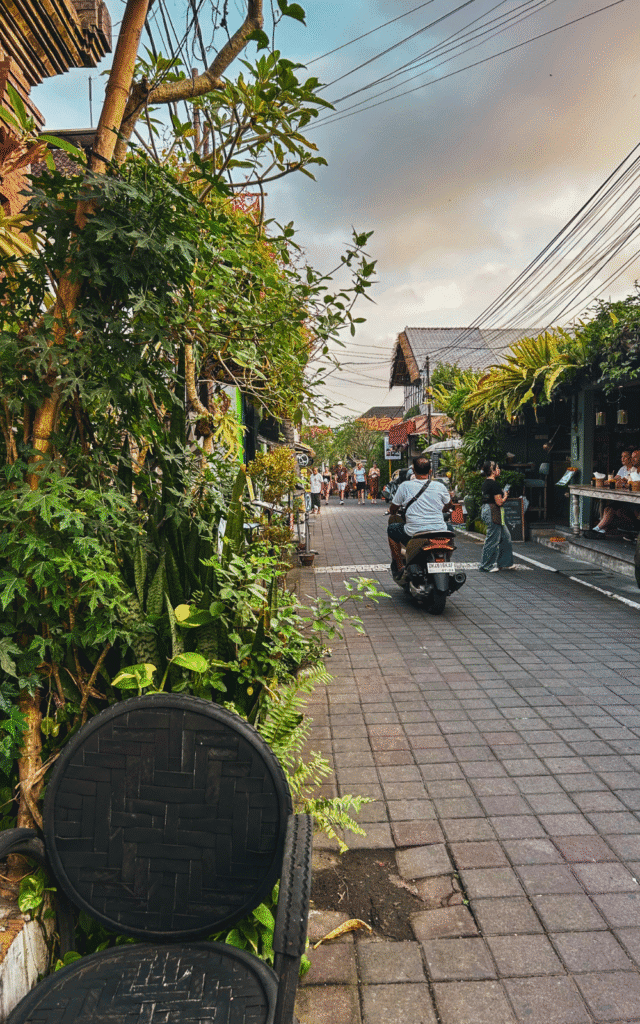
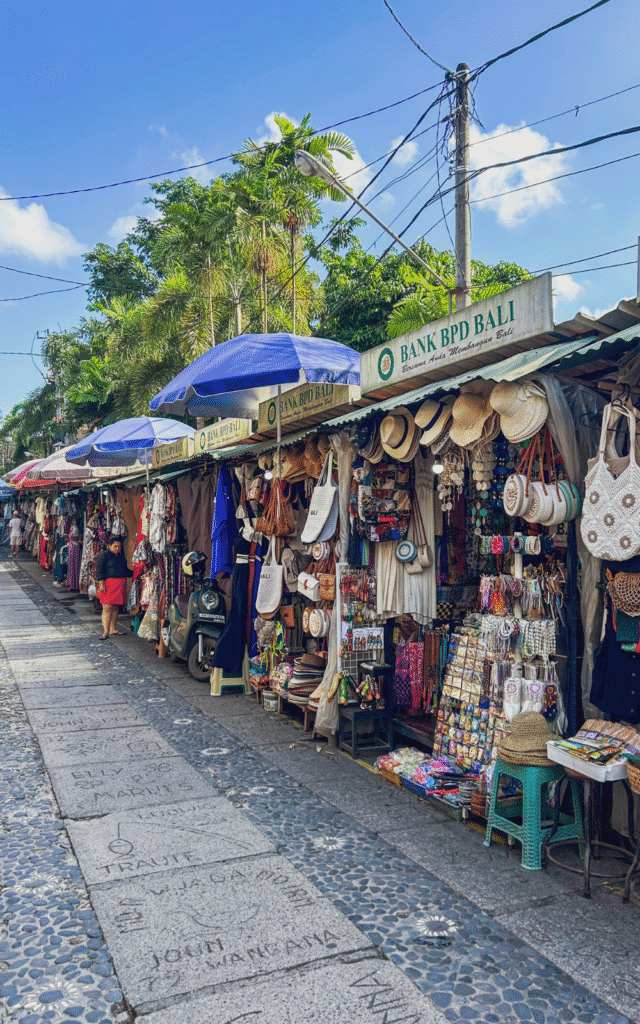
Before booking, consider whether you’d prefer to stay close to the city center (the main road) or tucked away, surrounded by rice paddies. Either way, your stay in Ubud will likely be peaceful. It’s not a party town, and most restaurants and bars close by 11 pm.
Below are some areas you can consider for your stay, and the best places to stay. And if you’re looking for a specific vibe or you want more information on some of them, I’ve written a small guide on the best areas to stay in Ubud, based on my experience finding a long-term stay here.
1. City Center: Jl. Sukma & Jl. Bisma
These two areas are pretty similar: located on opposite sides of the main road (Jl. Raya), both are lively little streets with a great atmosphere, lots of restaurants and Warungs, and within walking distance of the very center.
On Jl. Sukma, you’ll find more budget-friendly homestays and guesthouses, while Jl. Bisma offers a range of accommodations: resorts, hotels, and even hostels.
2. City Center: Rice Fields
If you’re looking for a stay immersed in nature but don’t want to be too far from town, you can look into the accommodations along the Sari Organik Walk and Juwuk Manis Walk (around Kajeng Rice Fields). These are my go-to rice field walks, and I always find myself admiring the guesthouses and pool villas along the paths.
Just so you know: cars don’t have access here—only scooters—so if you’re traveling with a suitcase rather than a backpack, be prepared to carry it on your way to the hotel.
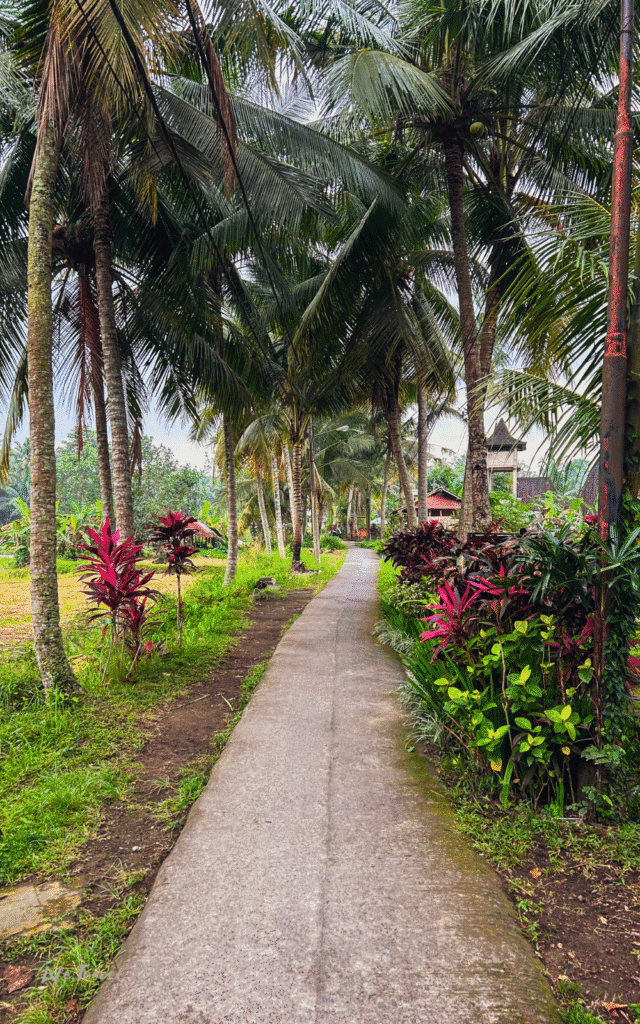
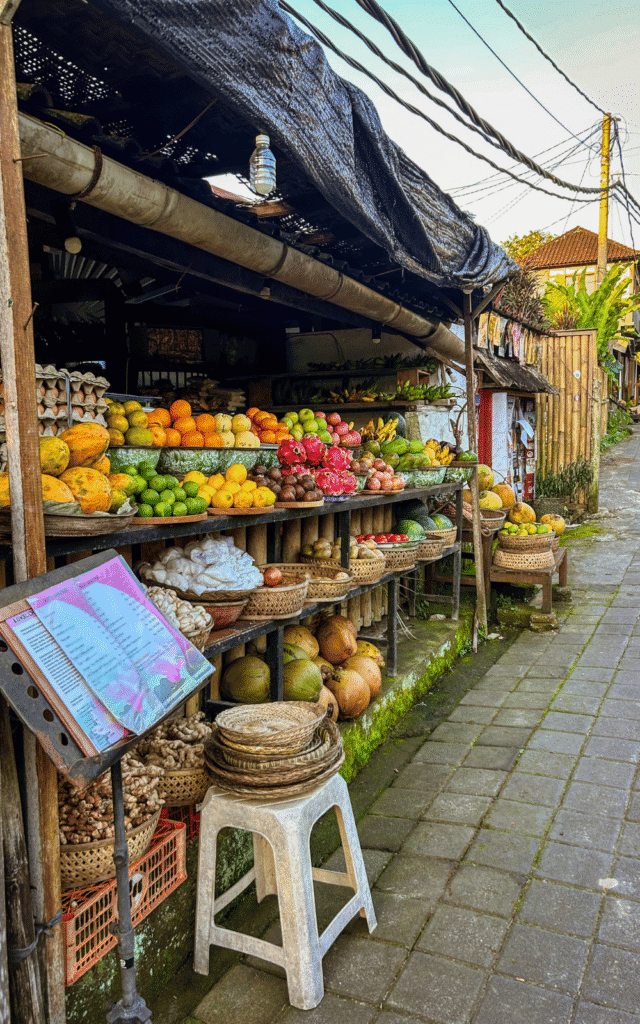
3. Traditional Village Vibe: Penestanan Area
To me, Penestanan is the most magical area of Ubud.
Located just north of central Ubud, you reach Penestanan by walking down the tree-lined road past Pura Gunung Lebah. As you head uphill, you’ll notice the energy shifts—things get quieter. This is where many expats and long-term travelers choose to live.
You’ll find plenty of guesthouses and pondok-style stays with jungle views, cute cafés to work from, peaceful rice fields, and some of the best yoga studios in town.
4. Luxury Resorts & Villas: Sayan & Kedewatan
Sayan and Kedewatan are located in the Ayung River Valley, just a short drive from central Ubud. This is where you’ll find luxury resorts like the Four Seasons and Mandapa, a Ritz-Carlton Reserve, but also stunning private villas and boutique stays hidden in nature.
Sayan and Kedewatan are farther from Ubud center—not walkable. You’ll need a scooter or a driver to get around, and restaurants or shops are more spread out.
Where To Stay in Ubud: Guesthouses, Hotels & Villas
Here are a couple of options you can consider for your stay in Ubud, adapted to every budget:
- Bisma Jaya Bungalow (Low budget): The rooms are simple, but the atmosphere is incredibly peaceful. The staff is so friendly and the garden is beautifully maintained. There’s a lovely swimming pool overlooking the surrounding nature. Each bed comes with a mosquito net, which is a plus in Bali — trust me, you’ll be grateful for it.
- Sens Hotel & Spa (Mid Budget) is located right at the entrance of Jl. Sukma is close to the main road. The building itself is hard to miss, and the outdoor pool is a real highlight. Despite its central location, the hotel remains quiet and peaceful.
- Pertiwi Bisma Ubud is great if you’re looking to be surrounded by nature while still sleeping in modern and cozy rooms. The breakfast is fantastic, and the hotel has two swimming pool areas to choose from.
- Candy Villa (medium-high budget): This is where my friend and I stayed in Ubud the first time. Candy Villa is a complex of independent villas surrounded by rice fields and cultivations. It’s ideal for couples or groups of friends (one villa can accommodate up to four people). The highlight for us was definitely arriving and discovering our beautiful bamboo villa with its private swimming pool! And the outdoor bathroom is a fun touch.


Where to Eat in Ubud: Warungs, Cafes With View, & Restaurants
One of my new hobbies here in Ubud is cafe hopping, and below I’m sharing all my favorite restaurants for breakfast, lunch, and dinner.
1. Breakfast: Smoothie Bowl or Scrambled Eggs?
Below you’ll find some of my favorite places for breakfast. If you’re craving more, I’ve compiled a full list of my favorite breakfast spots in Ubud.
- Clear Cafe: It feels like eating in a Japanese garden, surrounded by flowing water, koi fish, and plants. Here they have one of the best (probably the top 2) smoothie bowls I’ve had in Ubud. They’re open for lunch and dinner too, so it’s a place to check out at all times of the day.
- Blend Cafe: Here is the top one smoothie bowl I’ve had. It was the blueberry Acai bowl, and I’ve had a difficult time finishing it; it was so filling! It’s the kind of smoothie bowl that you don’t want to eat, because it looks like a work of art. Definitely on the pricier side (by Balinese standards), but so worth it!
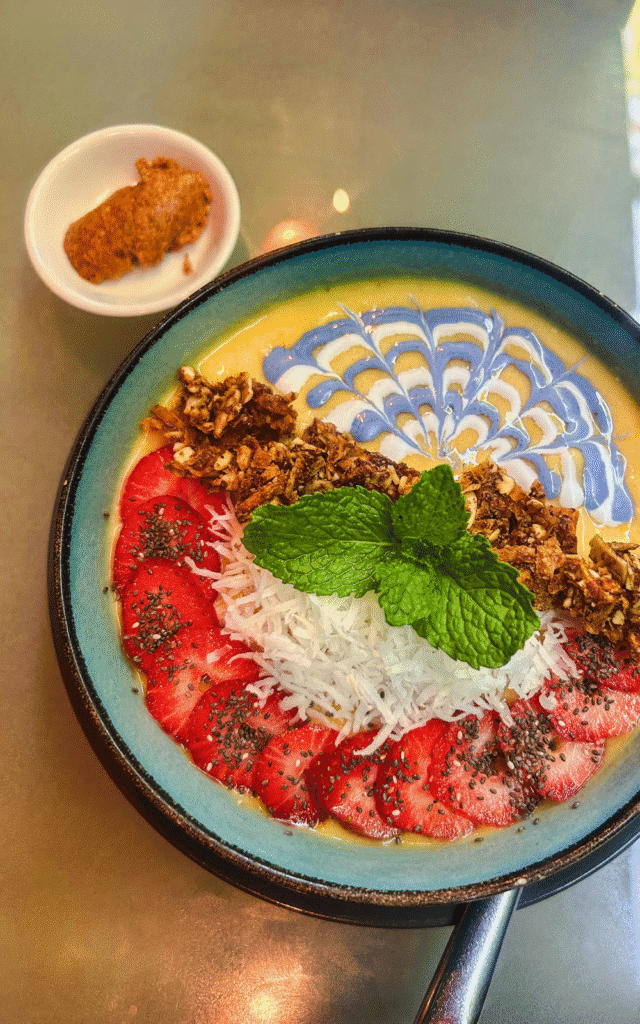
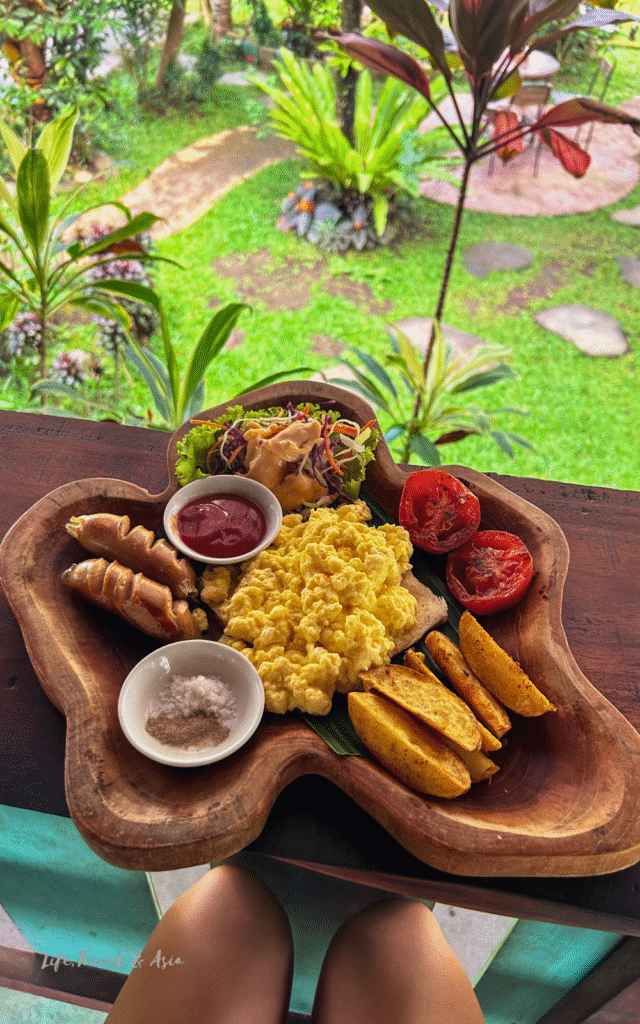
- Aldi’s Coffee & Eatery: Rice field views, filling smoothie bowl, but above all, the richest and cheapest savory breakfast I’ve had in Ubud. All of that in the picture for only IDR 71K (taxes included). If you sit at the high table, you’ll have the best view of their cute tropical garden! Aldi’s is one of those underrated gems that I’m so happy to have discovered in Ubud.
Lunch: Jungle Views or Warung Vibes?
If I had to suggest two places to have lunch in Ubud, they would be:
- Sweet Orange Warung: One of those places I keep coming back to, not only for the delicious and affordable food, but also for the lively vibe and the beautiful views of the rice fields. Every time I go, I always hang around for a bit after finishing lunch, just because it’s a nice place to be: full of other travelers, spiritual and calming music, and good food.

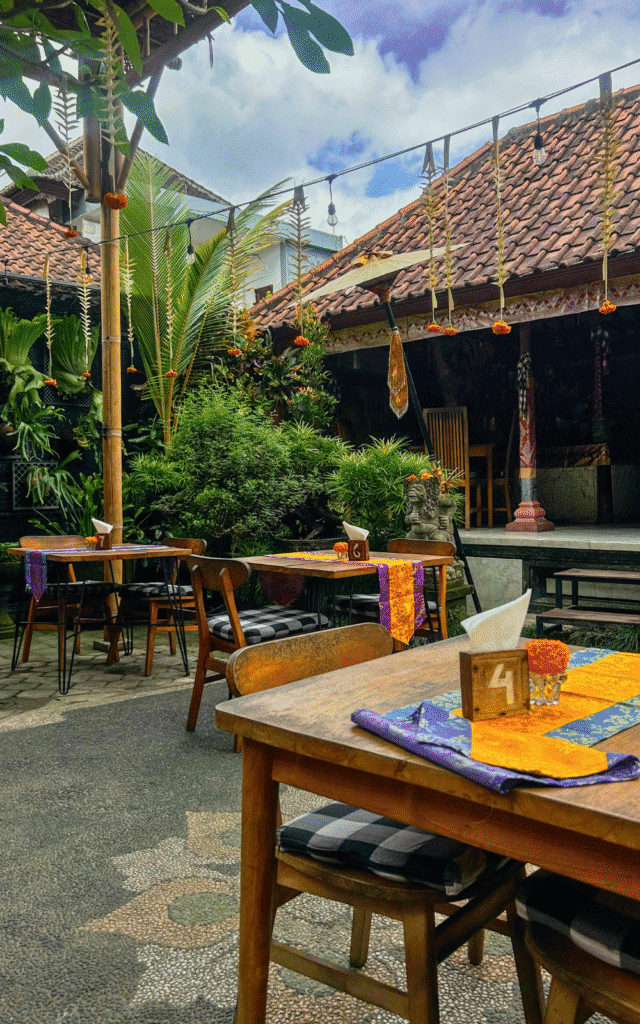
- Warung Gauri: One of my favorite warungs (also because it’s so close to where I live). They have one of the most complete menus I’ve seen, with plenty of options, including a seasonal avocado menu that I always order from.
3. Dinner: Western Cuisine or The Best Indonesian Food
When I first visited Ubud, I had one of the fanciest dining experiences while in Bali. If that’s not your thing, there are also plenty of warungs offering a modern atmosphere perfect for a nice dinner.
- Cantina Rooftop: If you’re looking for an upscale dining experience in a chic setting, then you can’t miss Cantina Rooftop. It is located on the second floor of a building overlooking the Campuhan Ridge Walk and offers beautiful jungle views, especially at sunset. Their 11-course tapas-style menu is a must-try for larger groups.
- Sun Sun Warung: Indonesian Warung in one of the most chic settings I’ve seen in Ubud. The restaurant is set in an open-air area across multiple levels, with painted walls, low lighting, candles, and a nice bar. Prices are, of course, a bit higher than most basic warungs, but still very affordable.
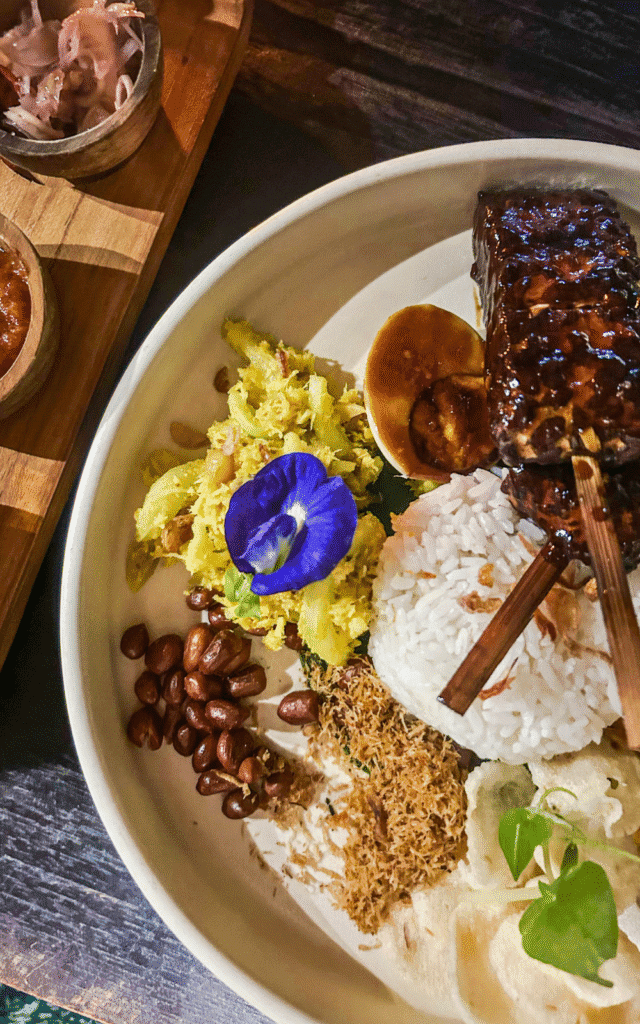
Looking for Places to Eat in Ubud? Here Are My Favorite Restaurants, Cafes & Warungs
What to Pack for Ubud: 5 Items You Can’t Miss
I honestly believe there’s no longer a distinction between rainy and dry seasons in Bali. We’re in August right now, and tomorrow I could easily witness the heaviest downpour. So when it comes to packing, be prepared for all kinds of weather.
Here are some items you definitely shouldn’t forget if you’re visiting Bali at any time of the year.
1. Sarong
Always carry a sarong in Bali. You never know whether it’s included in the temple’s entrance fee, and having your own is super handy. You can use it to cover up on the beach, wrap around your waist, or cover your shoulders when entering a temple.
2. Sneakers/Hiking Sandals & Flip-Flops
In Bali, you’ll probably live in flip-flops—unless you’re hiking or it’s raining. In those cases, pack a pair of sturdy walking sneakers (ideally not white unless you want them ruined).
3. Cross-Body Bag
A cross-body bag is great for scooter rides on Grab and Gojek, quick runs to the nearby market, or morning strolls.
4. Rain Jacket
As mentioned, expect showers. If you’re hiking a volcano when a rain shower happens, you may want to have a rain jacket with you. You can purchase a lightweight, foldable one like this one, which will not take up too much space in your backpack.
5. Insect Repellent
Mosquitoes are wild in Bali. Make sure to pack a strong DEET insect repellent and apply it whenever you’re outdoors or indoors, especially if the windows are open.
Need Help Packing? Here Are Bali Packing Guides
5 Top Things to Do in Ubud
There are so many fun activities to try while in Ubud (this is why I mentioned that 3 days are not enough). Here are five of my favorite things I’ve done in Ubud.
And if you’re looking for more things to do, don’t miss these 32 things to do in Ubud: from popular sights, hidden corners, and the best activities you can try for the first time here.
1. Stroll Through Hidden Rice Fields
The best way to get to know the real soul of Ubud is to take a stroll through the less-visited rice fields. And I’m not talking about tourist sights; these are real rice fields where you’ll meet farmers, locals, and kids playing with their kites.
At this point, I feel I can share my favorite and hidden rice field walks with you. My favorite? The one that goes from Kedewatan to Penestanan, passing by the most beautiful rice paddies in Ubud.
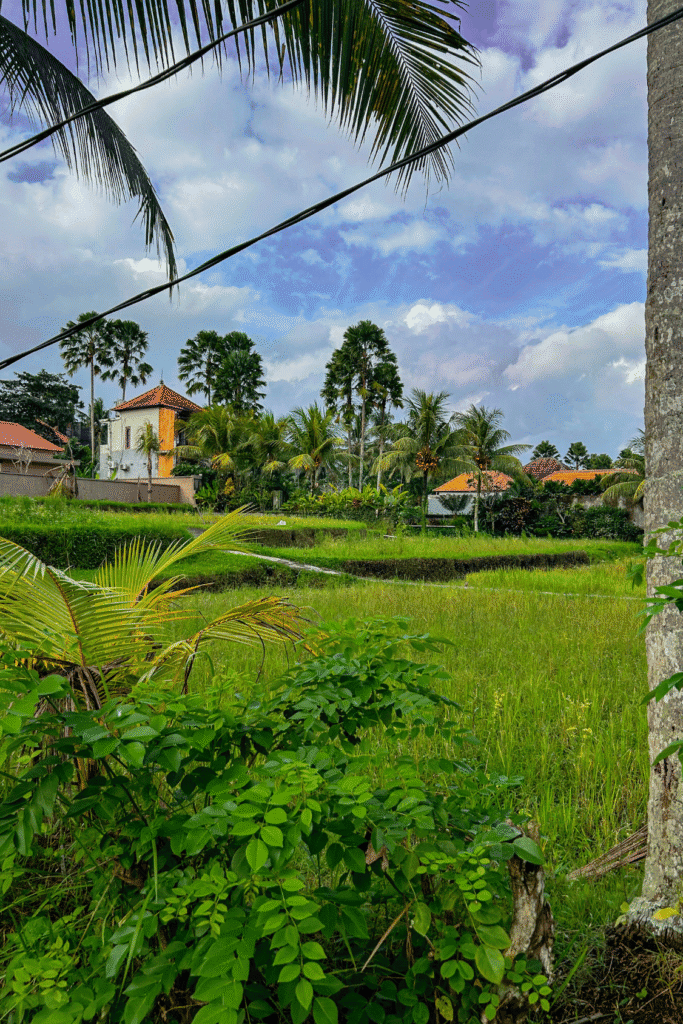
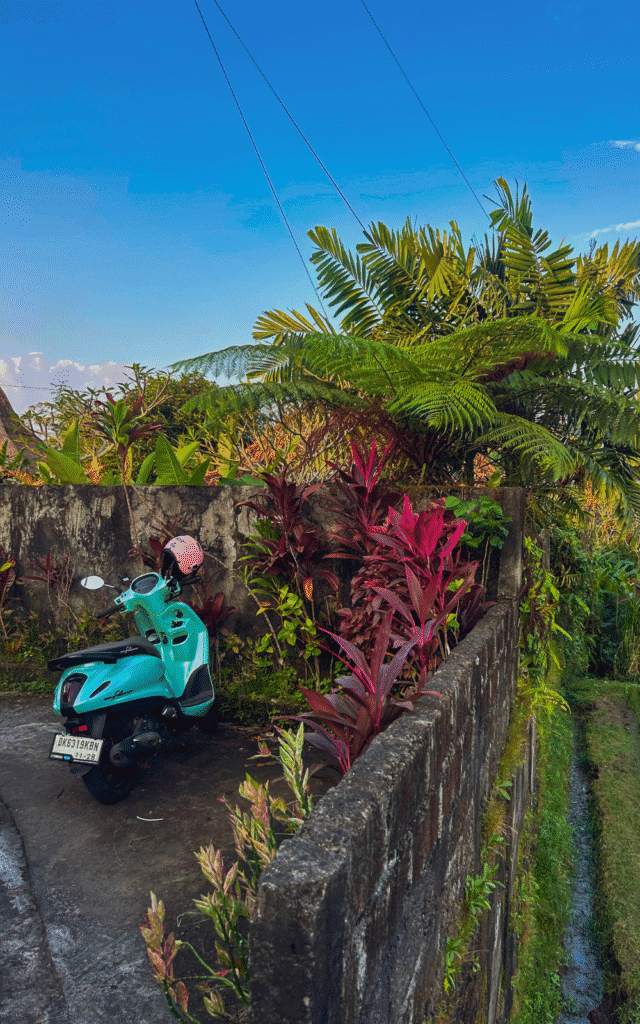
2. Whitewater Rafting on The Ayung River
Whitewater rafting was such a fun experience! Two hours of paddling down the river, navigating rapids, and enjoying the beautiful Ubud nature. The guides are fantastic and make the adventure even better!
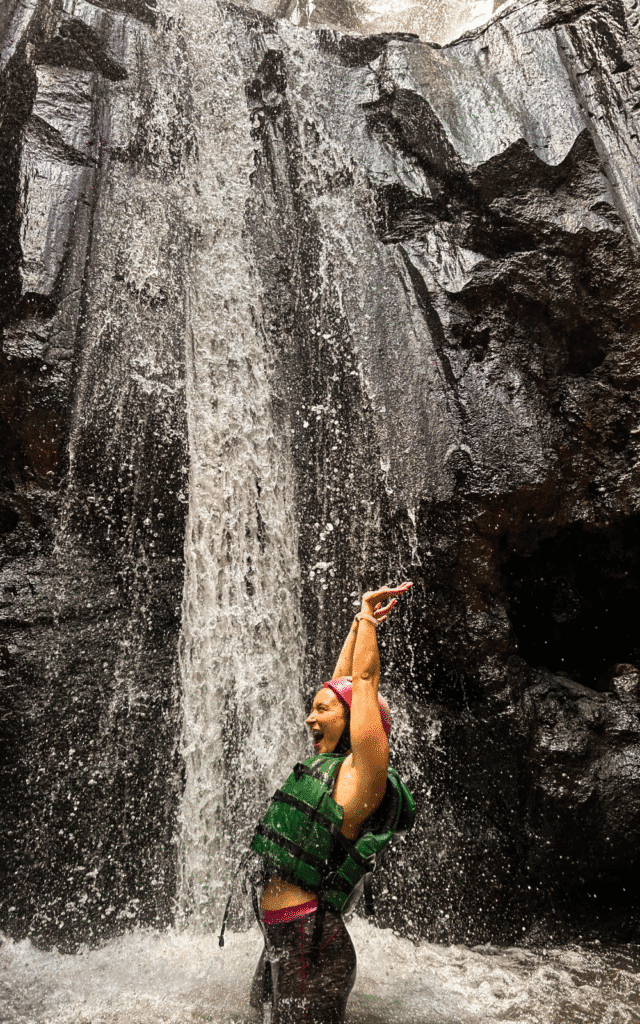
You can check out my whitewater rafting experience to prepare your trip: what to pack, the level of difficulty, the best tour, and what’s included. Honestly? When in Ubud, I would skip some of the most popular sights and save some time for the rafting; you won’t regret it!
3. Take a Cooking Class
Cooking classes are the best way to connect with the authentic Balinese culture. Cooking is such an important part (and ritual) of everyday life here, and having the chance to witness locals preparing food, learning about their culture, and understanding how they practice gratitude is one of the most enriching experiences.
I’ve written a blog post about my cooking and Canang Sari class. You can check it out and even book your own experience.
4. Take Part in a Purification Ritual
You don’t have to be Hindu to participate in a Melukat ritual. All it takes is believing in the power of rituals done with intention. The Balinese purification ceremony (or Melukat) is a way Balinese Hindus purify their mind, soul, and body from negative energies through the power of water coming from holy springs.

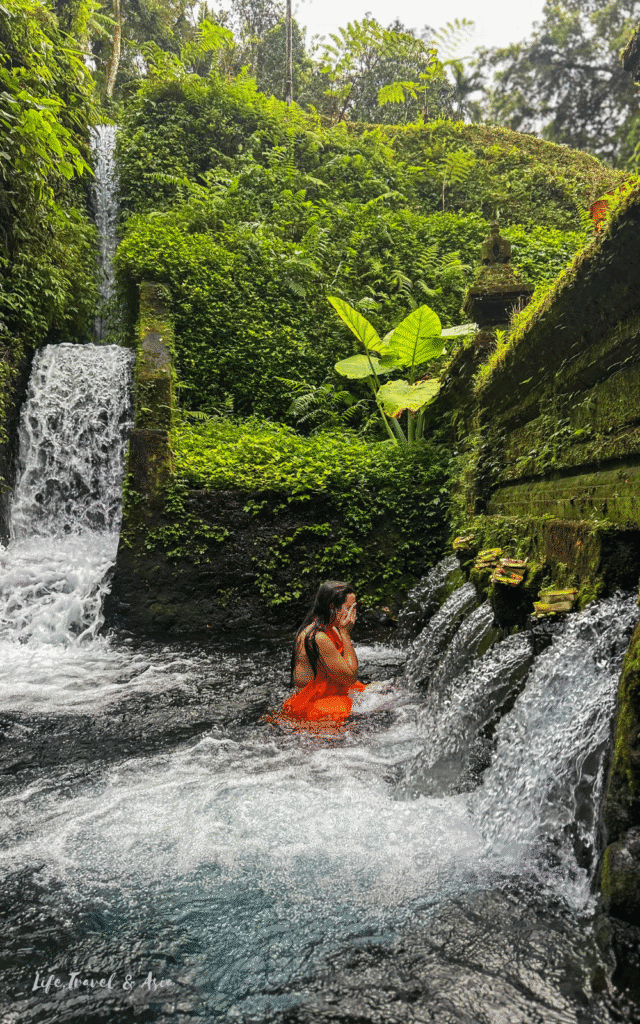
Done in the right way, the Melukat can be such a wholesome experience you’ll remember forever. I’ve had my first Melukat at Pura Mengening, right outside of Ubud, and it was the perfect setting. Everything was wonderful: the guide, the weather, the ritual, the silence of the temple.
Are You Looking for A Peaceful Temple Where to Practice The Melukat? Check The Articles Below
5. Saraswati Temple & Ubud Palace
I visited the Ubud Palace and the Saraswati Temple very early in the morning, right after opening time. These two iconic buildings showcase the beauty of Balinese architecture.
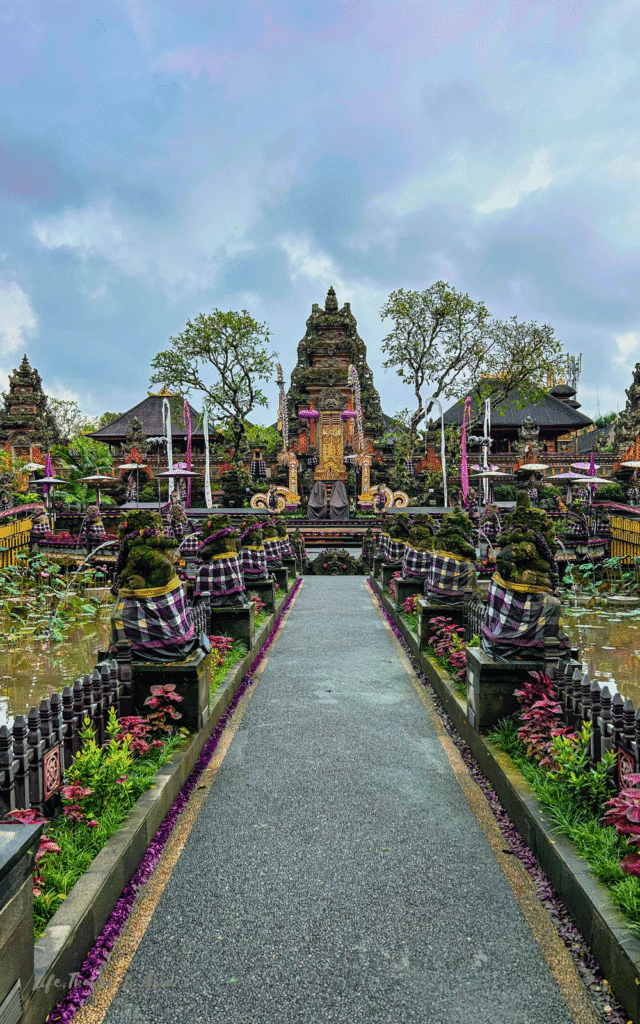
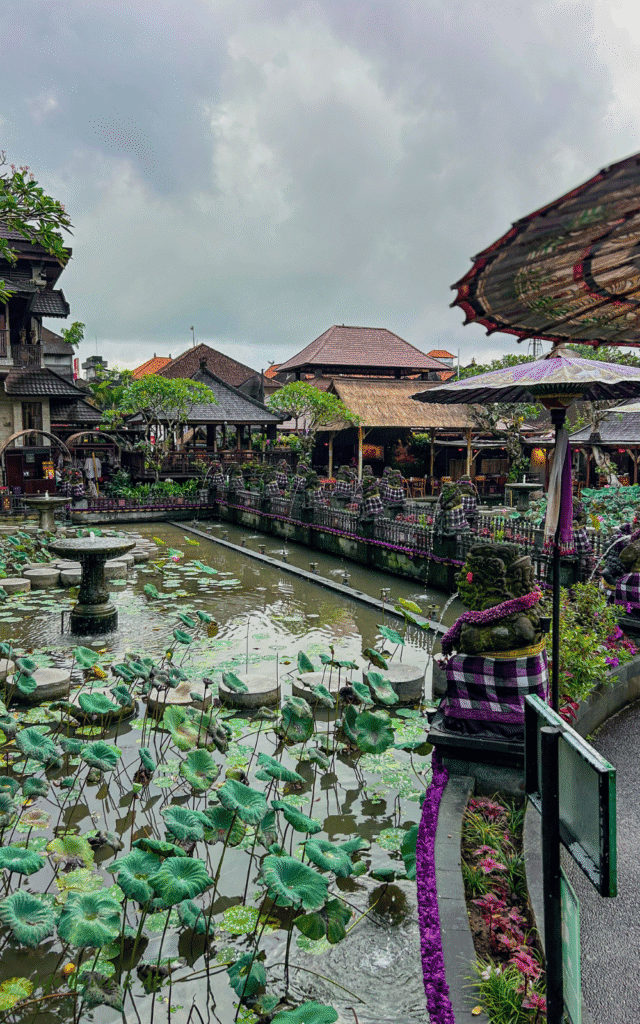
I loved the Saraswati temple in particular. While the garden (you can’t actually access the temple) is tiny, it is likely one of the most picturesque sights you’ll witness in Ubud. It feels so different from the typical traditional Hindu temples, and the famous lotus pond creates the dreamiest scenery.
The garden is small, but every little corner deserves your attention — from the bridge crossing the lotus pond, to the detailed statues decorating it, to the red sandstone gates standing at the corners of the garden.
5 Best Day Trips from Ubud
Ubud is a great base for exploring other sights in central and north Bali. Here are five fantastic day trip options if you want to escape the crowds in the city center.
1. Goa Gajah: Elephant Cave
One of the most popular sights to visit around Ubud is Goa Gajah (also called the Elephant Cave).
The highlight of the sight is, of course, the cave and the scary demon carving. However, the surrounding natural area, called the Buddhist temple, is one of the most beautiful tropical gardens I’ve got to see in Bali. Here, the nature is unbelievable, and to be completely honest, this is the real reason I think you shouldn’t miss Goa Gajah.
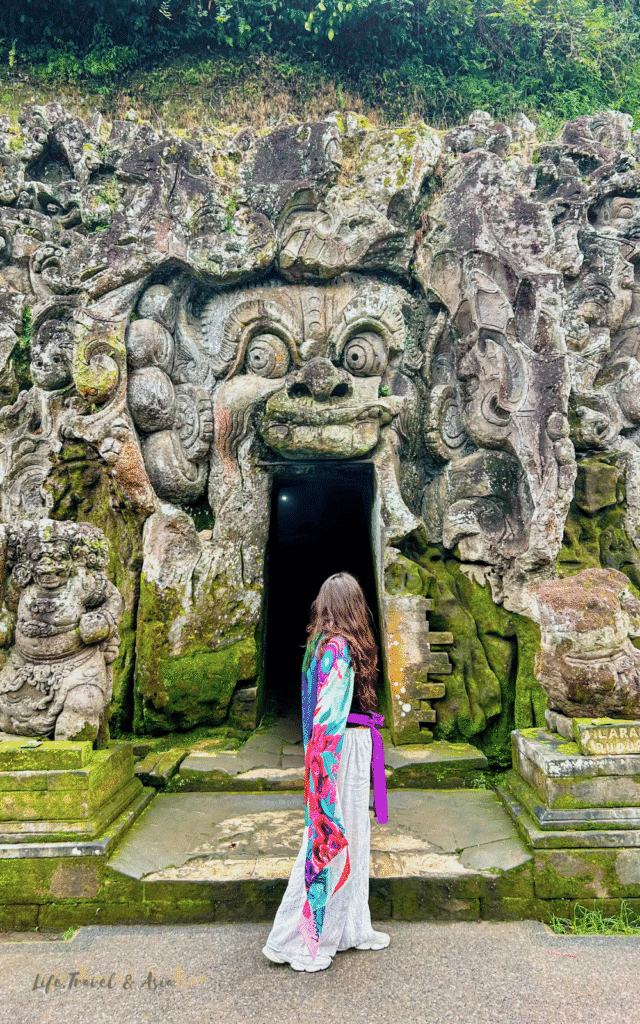
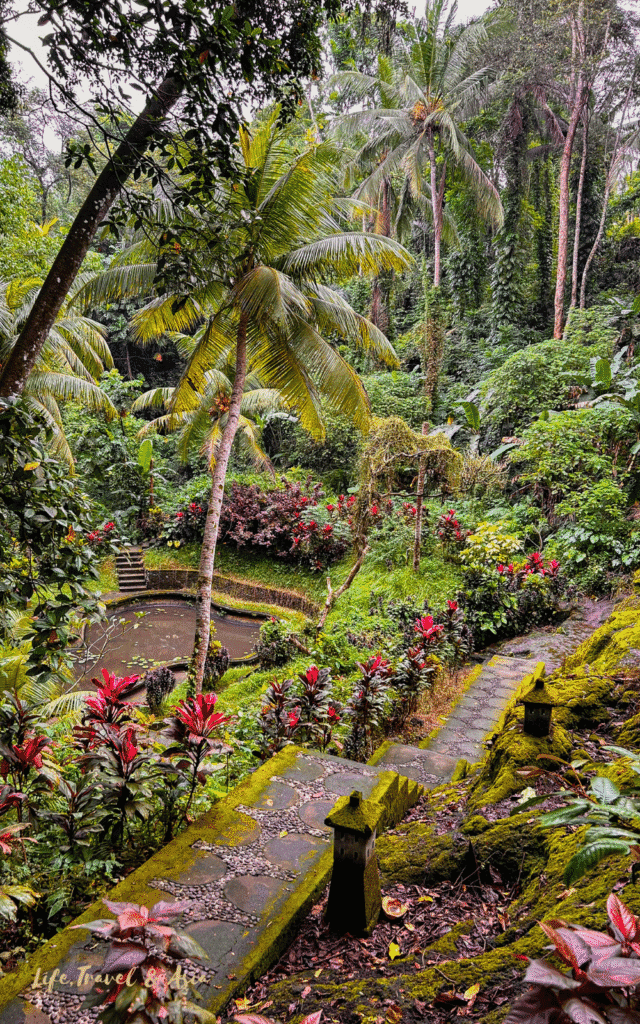
If the pictures looked too good to be true, you can actually check out my complete Goa Gajah guide and see it for yourself. You’ll find all the information you need to plan your trip from Ubud and what to expect once you’re there.
2. Kintamani & Mt. Batur Sunrise Hike
Kintamani, in North Bali, is only one hour from Ubud, but it feels like a completely different island. If you’re looking to escape the busy Ubud (or even just for a day) to enjoy unbelievable volcano views and experience a different (and perhaps more authentic) side of Bali, I highly recommend planning a couple of days in Kintamani.
If your itinerary is packed or you’re traveling on a budget, a Kintamani day trip is totally doable. You’ll still get to enjoy its stunning nature, fit in a sunset hike, and keep things affordable.
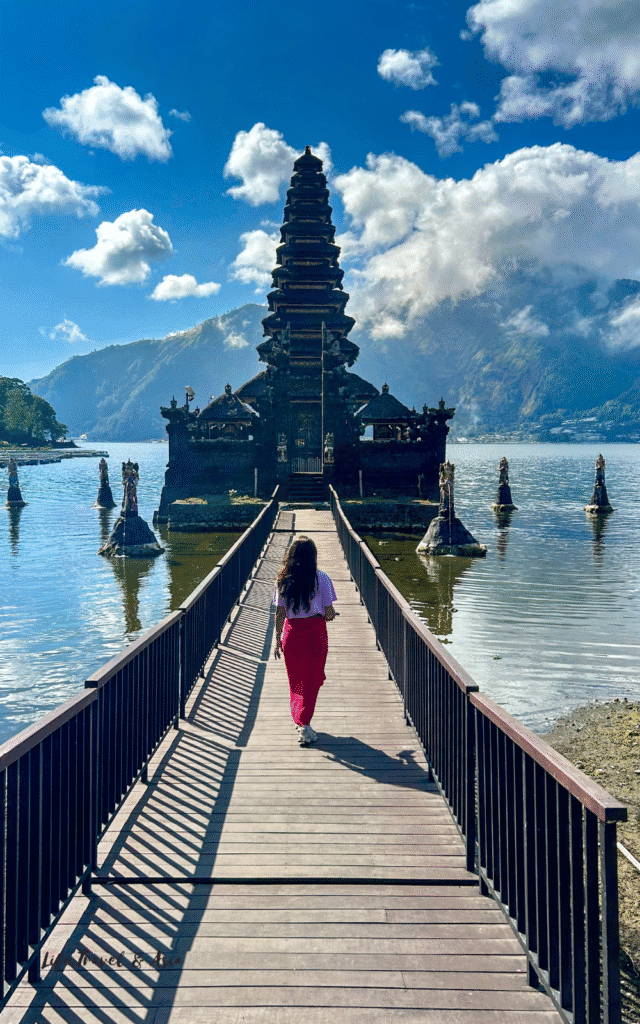
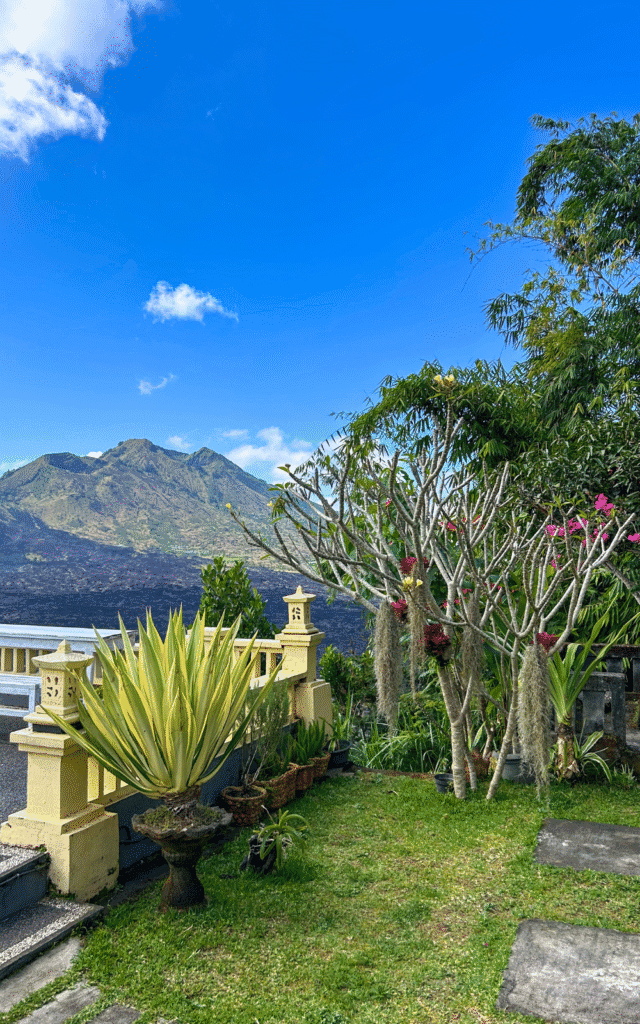
The most popular activity here is the sunrise hike on Mt. Batur, but you can even plan to go there in the morning, enjoy the area, have a sunset hike instead (if you want to avoid the early call), and come back to Ubud later in the day.
There are plenty of things to do in Kintamani. My favorite? A visit to Pura Ulun Danu Segara and a cycling session to explore the area and get to enjoy the views.
3. Bedugul: Waterfall, Water Temples & Rice Fields
This is the exact Central Bali day trip I will take my parents on, and the one I’ve had during my first time in Bali. The roads to Bedugul, located around 1.5 hours from Ubud, are the prettiest on the entire island: think extensive rice fields, traditional villages, and no traffic at all.
Honestly, this was the part of my first trip that I preferred. Around this area of central Bali, there’s plenty to do. To organize your day trip, I would stop at Jatiluwih Rice Terraces (the UNESCO-protected rice fields in Bali), the Leke Leke Waterfall (still my favorite waterfall in Bali), and Pura Ulun Danu Beratan (the most significant water temple on the island, perched on Beratan Lake).
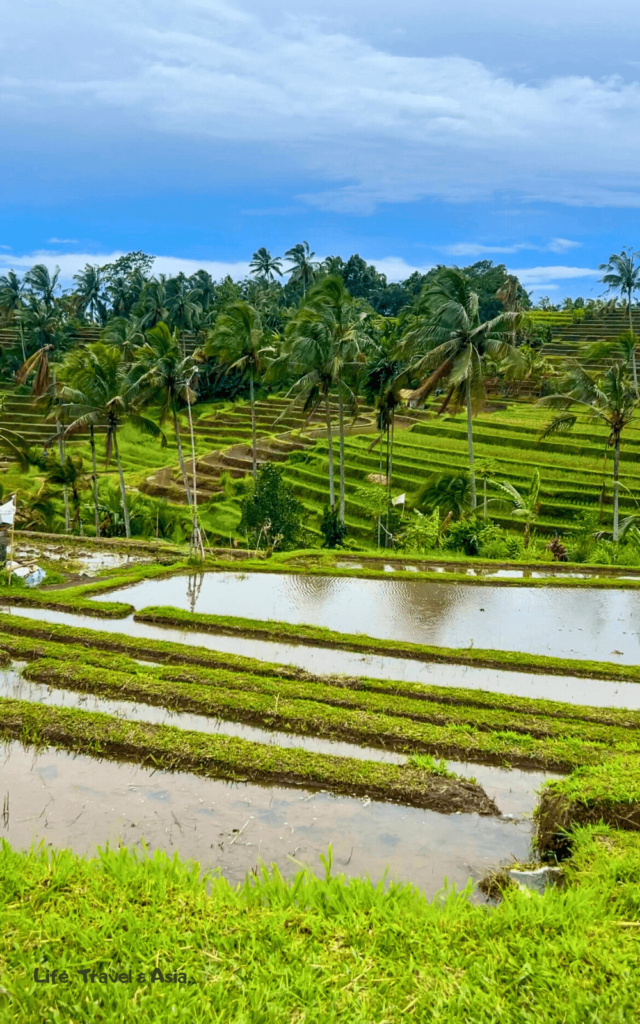
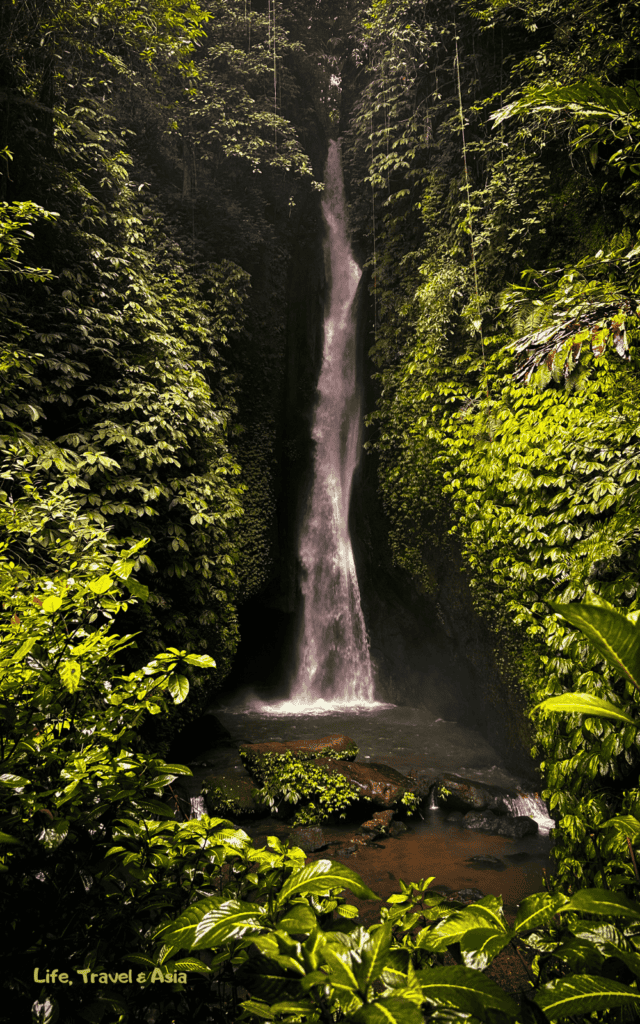
4. Waterfall Hopping Trip
One of the reasons I decided to base myself in Ubud is the numerous waterfalls in the area. And I’m not just talking about visitor favorites like Kanto Lampo and Tegenungan—you only need to open Google Maps to see how many waterfalls are scattered east and north of Ubud.
Some of the most incredible ones are Goa Raja, Tibumana, Tukad Cepung, and Taman Sari Waterfall, but there’s plenty to choose from. To organize your trip, you can easily book a Grab ride in the morning and ask the driver if they can take you to a couple of waterfalls for a few hours.
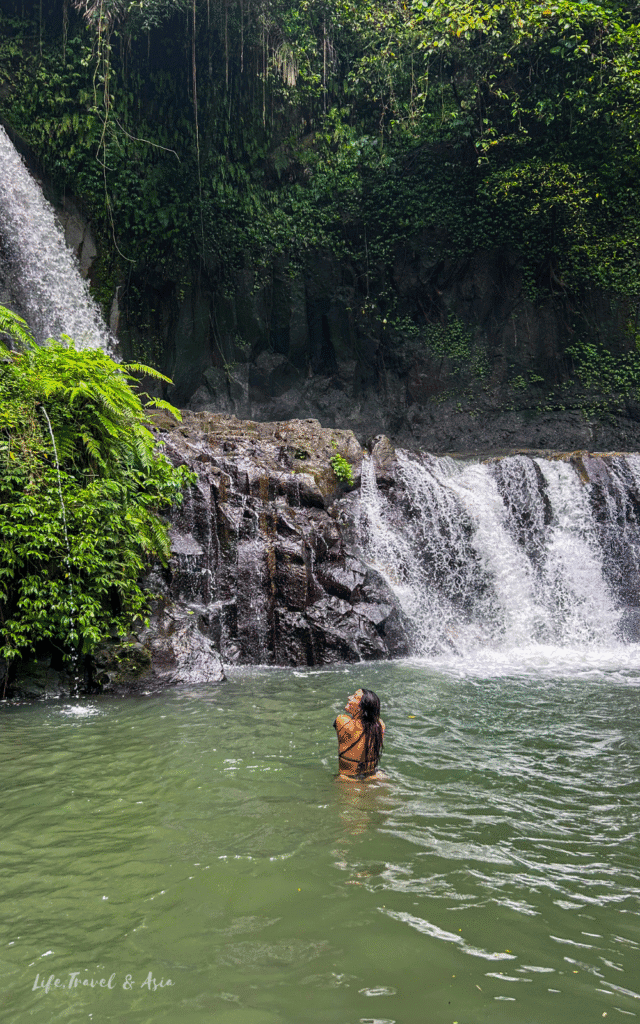
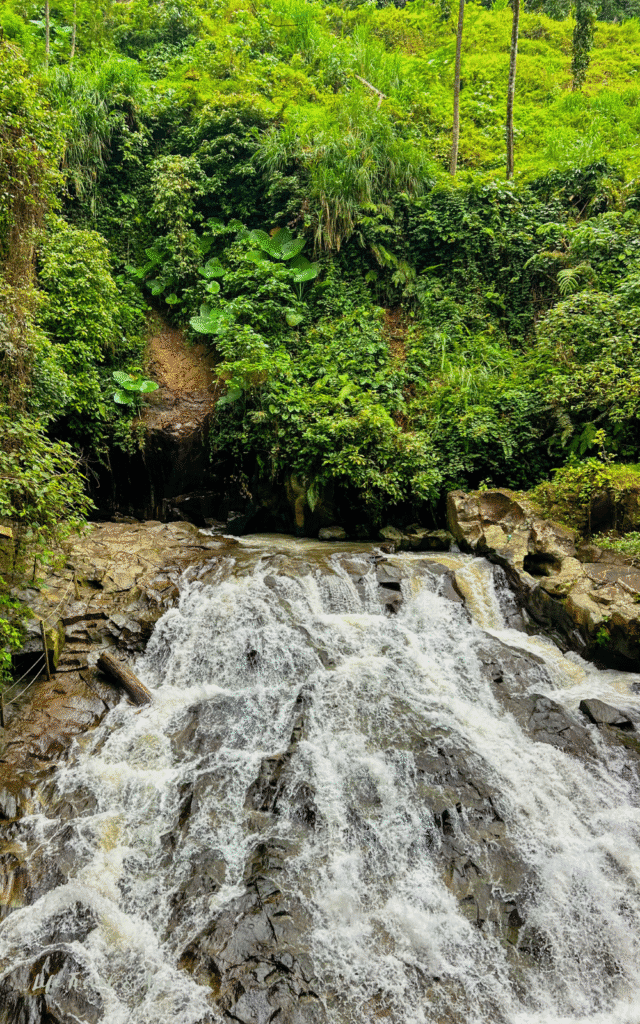
I highly suggest picking waterfalls that are close to each other so it’s easier for both you and the driver to plan your trip. I’d start from the ones farthest away and work my way back toward Ubud. If you feel comfortable riding a scooter, that’s an even better option—more flexible and budget-friendly.
If you’re looking for trip ideas, this is my waterfall-hopping itinerary just east of Ubud. It was so much fun to check them out early in the morning without the crowds.
5. Tampaksiring & Sebatu: The Most Beautiful Temples
There must be something in the air north of Ubud, because there are plenty of spiritual sights around the villages of Tampaksiring and Sebatu. They make for a perfect day trip, especially if you add a stop at the Tegalalang Rice Terraces, which are right in the middle on the way north.
The first one is, of course, Pura Tirta Empul — one of the most important water temples near Ubud, especially known for the Melukat Ritual. While I don’t necessarily recommend having your purification ceremony here, the temple is incredibly beautiful and absolutely worth visiting.
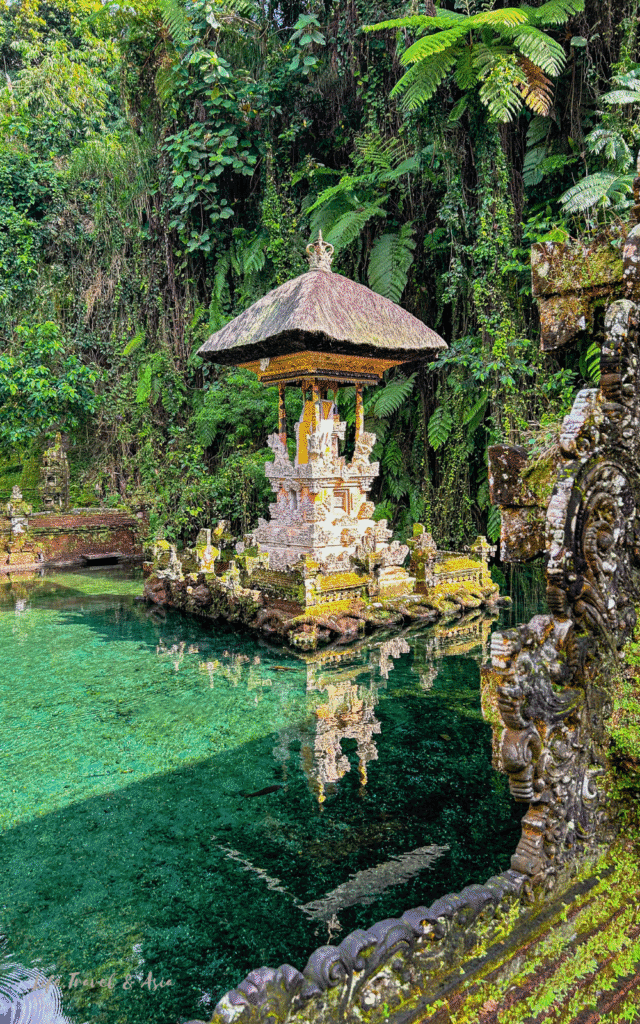

But that’s not all. Around Tirta Empul, you’ll find two hidden gems: Gunung Kawi Sebatu and Gunung Kawi Tampaksiring. Despite having almost the same name, these temples couldn’t be more different. Gunung Kawi Sebatu is, to this day, the most enchanting temple I’ve seen in Bali — small, but so beautifully decorated.
Gunung Kawi Tampaksiring, on the other hand, is less charming but has a mysterious atmosphere that makes it a must-see. It’s a funerary complex dedicated to past Javanese and Balinese kings.
If you’re a temple nerd like I am, you’ll love my post with the most suggestive temples to visit in and around Ubud.
Itinerary Ideas in Ubud
As mentioned, there’s plenty to do in Ubud, but there are also different ways to explore it: you can stick to the usual tourist trail or discover a quieter, more hidden side of the town. Whether you’re planning a day trip to Ubud or a 3-day stay, you’ll find some inspiration below.
One Day in Ubud: Usual Tourist Trail
This one-day itinerary includes the sights that first-time visitors won’t want to miss in Ubud. If you only have one day, you’ll likely experience most of them with crowds—unfortunately, there’s not much way around that. Ubud is very busy, especially around its most popular sights.
This itinerary includes: the Tegalalang Rice Terraces, Pura Tirta Empul, the Sacred Monkey Forest, Ubud Palace and Saraswati Temple, as well as the Ubud Market and a stroll around the rice field trails.
One Day in Ubud: The Tour I Would Take My Friends On
After living in Ubud for a while, I’ve been lucky enough to explore beyond the main tourist spots—and this is the exact itinerary I’d take a friend on to avoid the crowds and see maybe a more authentic side of the town.
This itinerary includes: Pura Mengening, Gunung Kawi Sebatu, some lesser known waterfalls like Suwat or Taman Sari, a relaxing afternoon at Ubud Sari Health Resort, and a sunset cocktail around the area of Sayan.
Planning a Day Trip to Ubud? Check out the itineraries below!
3 Days in Ubud: Local Culture, Temples & Nature
If you have more than a day in Ubud, you can mix the must-see spots (ideally visiting the most popular ones early in the morning) with hidden corners far from the tourist crowds.
For me, the perfect Ubud itinerary balances a connection with Balinese religion and its meaning—whether through a purification ritual or visiting a couple of temples—with some fun in town, like a fancy dinner, a brunch, or wandering through the market.
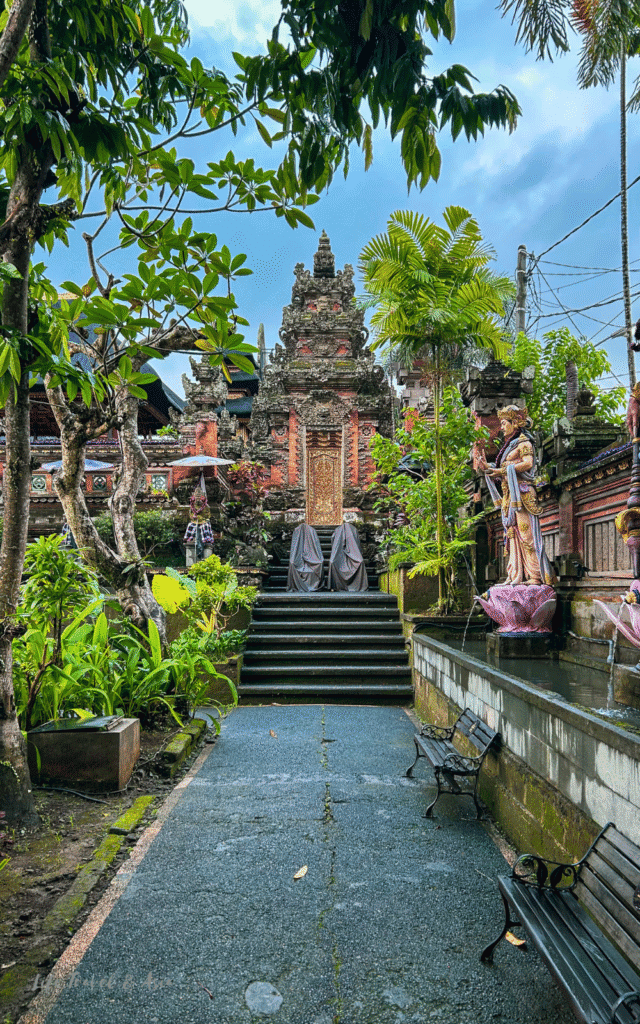
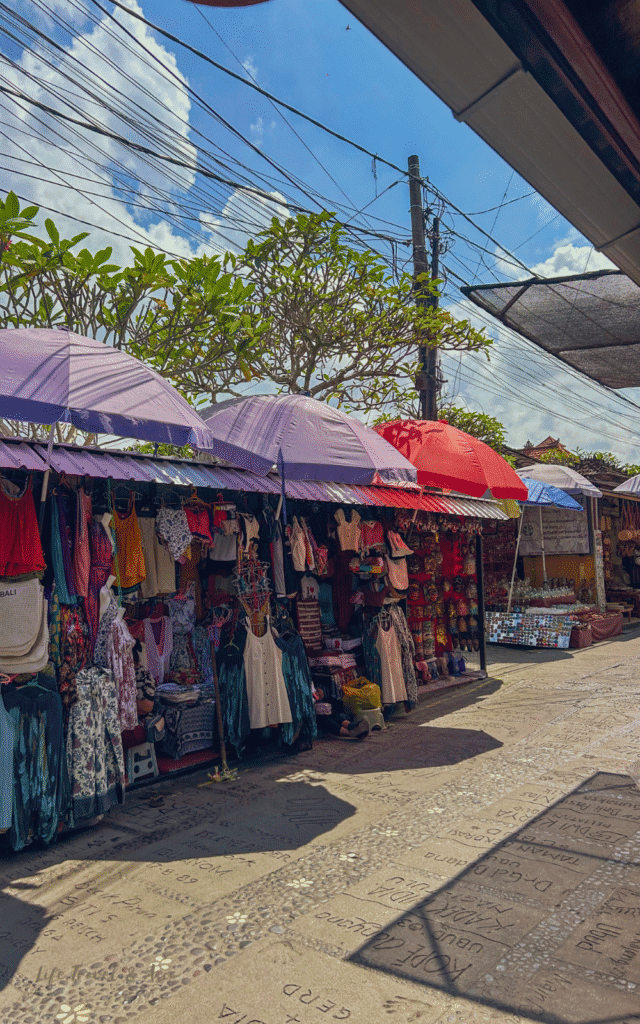
It also has to include time outdoors —maybe rafting or an ATV ride —and an experience with local traditions, such as a cooking class or learning to make a canang sari.
That’s precisely what I did on my first 3-day trip to Ubud—here’s the breakdown of my itinerary:
Day 1
- Monkey Forest
- Tegallalang Rice Terraces
- Pura Tirta Empul
- Ubud Palace
- Saraswati Temple
- Balinese Dance
Day 2
- Whitewater Rafting & ATV Experience
- Rice Field Walk: Juwuk Manis Walk
- Ubud Market & Jl Kajeng Market
Day 3: Day Trip to Central Bali
- Jatiluwih Rice Terraces
- Pura Ulun Danu Beratan
- Leke Leke Waterfall
Other Useful Travel Tips You May Need
1. Laundry in Ubud
Laundry in Bali can be a bit tricky. Sure, it’s available everywhere and super cheap, but then there’s the water quality… and the fact that about five times out of six, you either lose a garment or mysteriously gain a stranger’s T-shirt (true story, it’s happened to me!).
Since moving here, I’ve been going weekly to Suddha Eco Laundry, and honestly, if you want a fast (sometimes as quick as two hours!) and reliable laundry service, this is it. If you’re around Jl. Bisma, another great spot is I Care Laundry. They use sustainable detergents, and my laundry is ready overnight and smells amazing.
2. Wellness & Spa
If you’re looking for affordable spa and beauty treatments, I highly recommend Ubud Sari Health Resort.
I visited for a facial and a massage, and while there are cheaper options (this one is IDR 250k, which is still reasonable), the quality of the treatment here was among the best I’ve had in Bali.
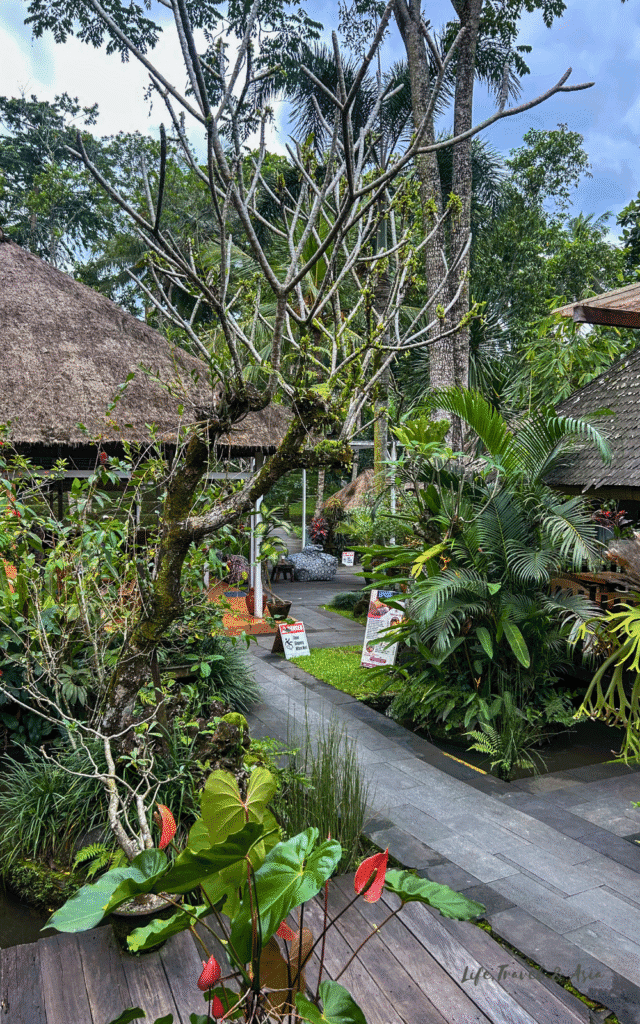
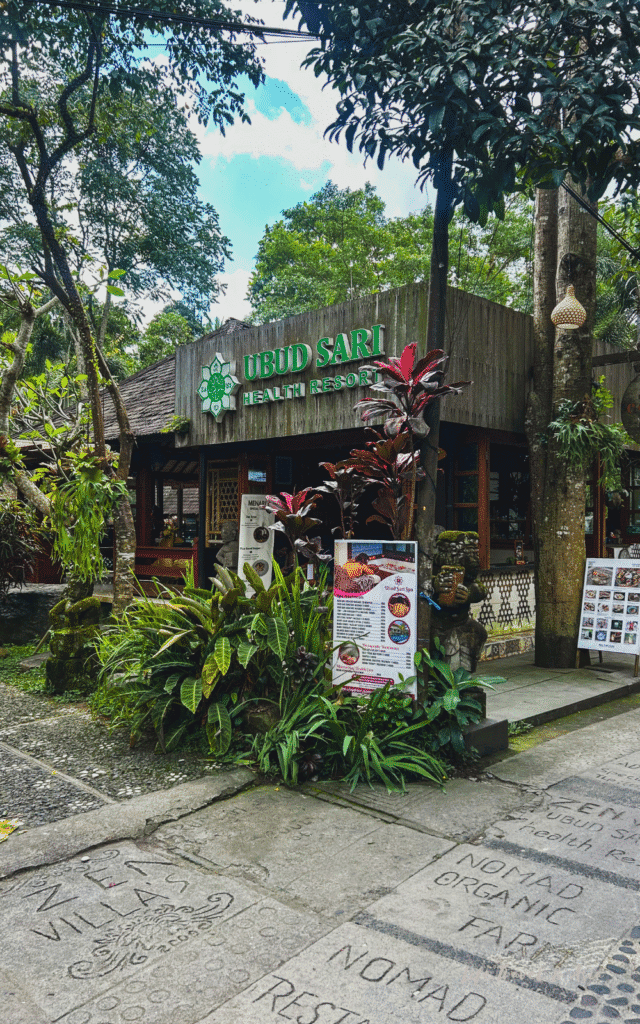
Plus, the resort is set in a beautiful tropical garden with fountains, views of rice fields, and greenery.
If, on the contrary, you want to splurge, then you have to try INKA Spa on Jl. Monkey Forest. I’ve been there for my birthday, and there’s honestly no better spa in Ubud. Prices are definitely higher, but you’ll understand why as soon as you step inside.
3. Fitness & Yoga Classes
As a digital nomad living here, I can tell you that Ubud is the perfect destination if you’re dreaming of combining sightseeing with a class or two.
The town is full of well-equipped gyms, fun dance and pilates classes, and, of course, some of the best yoga in the world. But it doesn’t stop there—if you’re more into slow practices, you’ll also find sound healing, nervous system rewiring, and breathwork.
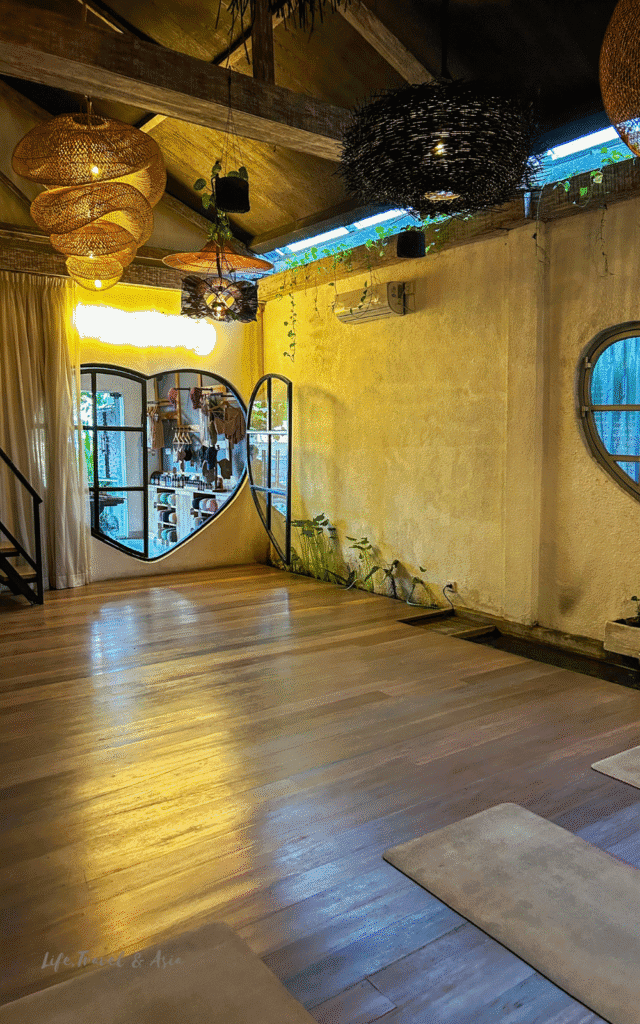
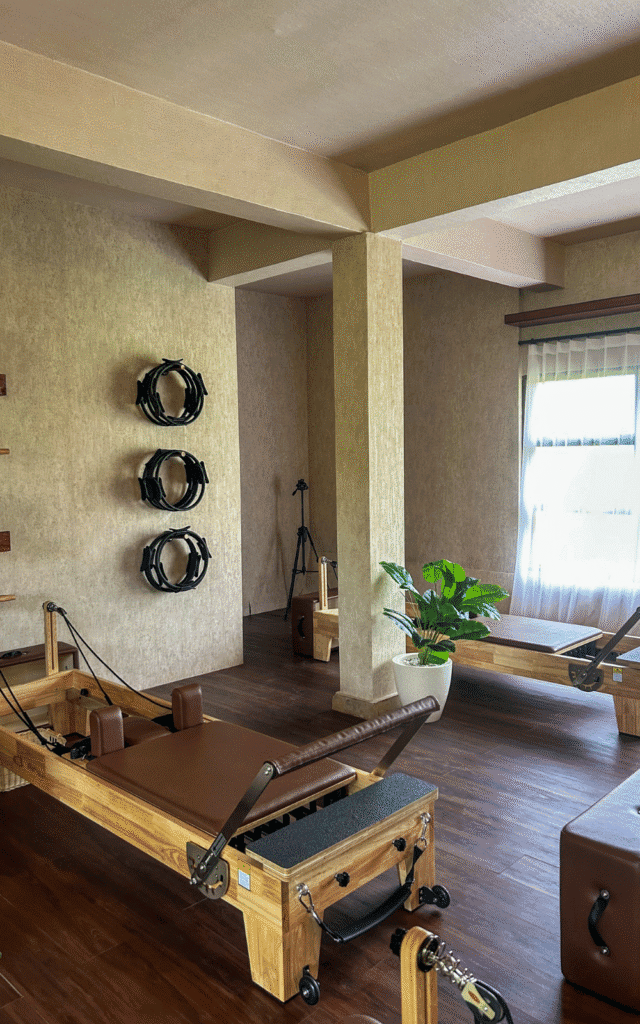
If you want to know where to start, I’ve rounded up my favorite eight fitness studios and classes in Ubud that I’ve personally tried. And if you’re curious about maintaining balance beyond workouts, you can check out my guide on how to stay connected to your body while traveling abroad.
So there you have it—hopefully this Ubud travel guide gave you everything you need (and more) to experience Ubud in the best way, plus some extra tips to make your stay even smoother.
If you’ll travel to Ubud soon, check out my list of 32 Things to Do in Ubud. You’ll find it all—from the must-see sights to hidden corners, cultural experiences, fun activities, craft classes, and more.
Now I want to hear from you! What are you most excited to discover in Ubud? What’s on your itinerary? Share your plans in the comments—and if you have any questions, just ask. I’m happy to help.
Articles You May Find Useful to Plan Your Trip To Ubud
- 12 Best Day Trips From Ubud: Hidden Waterfalls, Sacred Temples & Sandy Beaches
- 3 Days in Ubud: The Perfect Itinerary for First-Time Visitors
- Sangeh Monkey Forest vs Ubud Monkey Forest: Which One’s Best for You?
- Temples to Visit in Ubud: 10 Must-See Spiritual Sites & Water Temples in Bali
- 18 Best Places to Eat in Ubud: 2025 Foodie’s Guide for All Budgets
- Trip To Ubud: 2 Itineraries for Every Kind of Traveler
Did you find it helpful? 📌 Save it on Pinterest!


